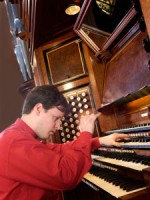Title
Few composers in history have exerted such extraordinary and far-reaching influence on music as Johann Sebastian Bach. But while many audiences know and enjoy the “Brandenburg” Concertos, B-Minor Mass, Well-Tempered Clavier, and other prevalent works, not everyone is similarly acquainted with Bach’s vast output for the organ. Some of his most important compositions were written for that instrument, and becoming more familiar with them can only intensify our fervor for the great composer.
Body
Paul Jacobs, the chair of Juilliard’s organ department, is well known for his interpretations of Bach’s music. Jacobs has performed all of the composer’s works for organ (more than 200) several times, including a single, 18-hour marathon concert in 2000, during which he played the entire repertoire in one sitting.
Jacobs will give a concert of Bach on September 15 as the first performance of Juilliard’s 2009-10 season. Jacobs has chosen an intriguing focus—not the flamboyant toccatas and fugues, not the often mystical chorale-preludes, but rather the ebullient Trio Sonatas, BWV 525-530. These pieces were perhaps conceived, and are certainly used, to build technique on an instrument that is played with both hands and feet.
Written for the organ or pedal clavichord (a practice instrument for organists), these sonatas require the right and left hands to play independently melodic lines on separate keyboards, while the feet play the basso continuo. According to Jacobs, “The organ sonatas are disarmingly attractive and immediately appealing to the listener, though they pose ferocious interpretive and technical demands for the player.” A significant challenge of performing these works is one of sheer coordination: playing three lines of music on two keyboards and pedal with all four limbs. “There isn’t much for the performer to cling on to,” Jacobs said. “It’s a little like walking on eggshells.” By contrast, in other weightier organ and keyboard works, Bach sometimes employs thicker four- or five-part counterpoint, offering a more idiomatically conceived keyboard texture.
The Trio Sonatas are found in an autograph dating from Bach’s first few years in Leipzig, where he lived from 1723 until his death in 1750. In his 1802 Bach biography, J.N. Forkel writes that “Bach wrote them for his eldest son, Wilh. Friedemann, and it must have been by practising [sic] them that Friedemann became the great organist that he afterwards was. One cannot say enough of their beauty. They were composed when the author was in his most mature period and may be considered as his chief work of that description.” It was not uncommon in the Baroque era for composers to rework their own (or another composer’s) musical material; for example, the first movement from the E-Minor Sonata, BWV 528, was originally an instrumental trio in Cantata 76 scored for oboe d’amore, viola da gamba, and continuo, and Bach later recast the Adagio e Dolce from the D-Minor Sonata, BWV 527, as the middle movement of the Triple Concerto, BWV 1044.
Organists must choose from a myriad of sounds available on a particular instrument. This is accomplished by selecting various “stops,” usually activated by draw-knobs on either side of the organ’s keyboards. The same music can sound drastically different from player to player, depending on the personal selection of stops, a process known as “registration.” Registration of Bach’s Trio Sonatas varies particularly widely. Many organists prefer that the three musical lines remain distinct in tone color to allow Bach’s counterpoint to be heard most clearly, but there are others who believe that the sonatas benefit from a similarity of timbre in the voices, as would be the case if two violins were to play the top two lines of these works. Some organists get into brawls over such matters!
Juilliard possesses several pipe organs built in various styles and this year welcomes a new instrument by the Schoenstein Company of San Francisco. Unlike the current piano manufacturing industry, which is dominated by just a few builders—Steinway reigning supreme—there are dozens of fine organ builders in the United States alone, producing instruments of often radically different tonal, mechanical, and aesthetic varieties. The Holtkamp organ in Paul Hall should be particularly well suited to a performance of Bach’s sparkling Trio Sonatas.
“Performers and scholars alike justifiably concern themselves with the sophisticated matters of appropriate style and good taste,” Jacobs said, “but somehow the universal genius of Bach ultimately makes such chattering seem relatively mundane. Thank goodness.”





